Fruit Crops Edition
Seasonal updates on diseases, insects, weeds impacting tree fruit and small fruit (blueberry, cranberry, and wine grape). Fruit Pest Alerts are also available via this category feed.
Subscriptions are available via EMAIL and RSS.
EPA Releases Temporary Guidance on Respiratory Protection for Agricultural Pesticide Handlers During COVID-19
Hand Sanitizers for Use in the Field
Under the “Interim COVID-19 Guidance for Migrant and Seasonal Farmworkers, Their Employers, and Housing Providers”, employers are required to provide hand sanitizers with at least 60-95% alcohol in various locations and employers are to schedule handwashing breaks every hour. If soap and water are not available, an alcohol-based sanitizer that contains 60-95% alcohol may be used. Hand sanitizers may be difficult to find, but a grower can make their own. Visit the onfarmfoodsafety.rutgers.edu website for a factsheet entitled “Home-made Hand Sanitizer”. This walks you through how to make a cheap effective sanitizer.
The next question is, what is the proper method to apply and use the sanitizer? Research has shown that a two-step sanitizer method is the best method for alcohol-based sanitizers.
- Step 1: Apply three pumps of sanitizer from the dispenser.
- Step 2: Rub hands for 20 seconds making sure to cover the palms, backs of hands, and between fingers up to the wrists.
- Step 3: Wipe the hands on a disposable paper towel.
- Step 4: Apply one pump of the sanitizer from the dispenser.
- Step 5: Rub hands until dry.
Hand sanitizers do not take the place of handwashing before starting or returning to work; after using the toilet; before and after eating and smoking; before putting on gloves; after touching animals or animal waste or any other time hands may become contaminated under the Food Safety Modernization Act or for most audits.
FDA Provides Flexibility to Farms Regarding Eligibility for the Qualified Exemption Under the Produce Safety Rule
The U.S. Food and Drug Administration announced that it will provide flexibility regarding eligibility criteria for the qualified exemption under the Produce Safety Rule during the COVID-19 public health emergency.
Under the FDA Food Safety Modernization Act (FSMA) Produce Safety Rule, farms are eligible for a qualified exemption and associated modified requirements if they meet certain criteria:
- The farm’s food sales averaged less than $500,000 (adjusted for inflation) per year during the previous three years; and
- The average value of the farm’s sales to qualified end-users exceeded the average value of the farm’s sales to all others during the previous three years. A qualified end-user is either (a) the consumer of the food or (b) a restaurant or retail food establishment that is located in the same state or the same Indian reservation as the farm or not more than 275 miles away.
Because of COVID-19, state and local governments across the United States have instituted public health orders that have resulted in many restaurants and retail food establishments either closing or significantly limiting their operations, leaving many farmers without their usual buyers. The guidance intends to allow affected farmers to shift their sales away from qualified end-users while still being considered eligible for the qualified exemption. Specifically, under the temporary policy announced in the guidance, farms that are currently eligible for the qualified exemption and associated modified requirements will still be considered eligible, even if they shift sales away from qualified end-users, so long as they continue to meet the requirement that their average food sales during the previous three years total less than $500,000 (adjusted for inflation).
FDA recognizes that providing flexibility to farms to allow them to shift food sales to available buyers during the COVID-19 public health emergency can help reduce food waste and food shortages. This temporary policy is intended to remain in effect only for the duration of the public health emergency, after which the FDA intends to issue additional guidance.
Qualified exempt farms must comply with modified requirements under the Produce Safety Rule, which include establishing and keeping certain records and prominently displaying their name and business address on food packaging or at the point of sale. Farms are responsible for ensuring that the food they produce is not adulterated under the Federal Food, Drug, and Cosmetic Act (FD&C Act) and they should use good agricultural practices to ensure the safety of their produce.
Sparganothis Fruitworm Degree-Day Update: as of June 01, 2020
As we approach bloom, Sparganothis fruitworm, spotted fireworm, and blackheaded fireworm adults will start to emerge. Growers need to start monitoring for Sparganothis adults using pheromone traps. As in previous years, I will be tracking the activity of Sparganothis adults using a degree-day model we developed in collaboration with Dr. Shawn Steffan from University of Wisconsin-Madison/USDA-ARS. Based on our degree-day model for Sparganothis, flight initiation is expected at around 596 DD (using March 1 as biofix; see chart). As of June 01, Sparganothis has accumulated 345 DD (using April 15 as biofix). Last year, at around this time, Sparganothis had already accumulated 529 DD. This means we are about one week behind from last year. This indicates that flight activity has not started and will not start until about 10-11 days from now. Growers are advised to place pheromone traps for monitoring this pest by the end of this week or, at the latest, by early next week.
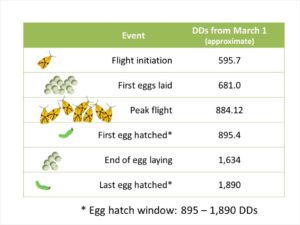
Sparganothis fruitworm degree-day model
Signage for Farm Worker COVID-19 Education Available
NJ Secretary of Agriculture Douglas Fisher has requested the following message be shared with the farm community.
To assist farm operators in the provision of COVID-19 education, the NJ Department of Health has created a set of prevention messages that can be used as signage to be hung in common areas on farms. [Read more…]
Specialty Crops Injury Caused by Dicamba Herbicide Drift
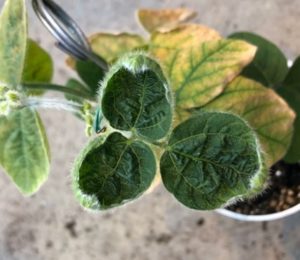
Figure 1. Non-tolerant soybean foliage when exposed to a sublethal rate of dicamba 2 weeks after treatment. Leaves are cupped with the bottom edges curved towards the top surface of the leaves.
By Maggie Wasacz1 and Thierry Besancon2
1 Rutgers Weed Science Graduate Student; 2 Rutgers Weed Science Extension Specialist for Specialty Crops
Glyphosate-tolerant soybeans were first commercialized in 1996 in the United States. By 2006, almost 9 out of every 10 soybean acres were planted with glyphosate-tolerant cultivars. However, reliance on glyphosate alone for soybean weed control stimulates the selection of weed biotypes naturally resistant to glyphosate. By 2019, there were 43 weed species known to be resistant to glyphosate, including species such as Palmer amaranth or waterhemp that can easily out-compete soybean and reduce yield by more than 50% if left uncontrolled.
What is Dicamba Herbicide?
One way to control glyphosate-resistant weeds is to treat them with herbicides other than glyphosate, such as dicamba. Dicamba is a synthetic auxin herbicide that has been used to control broadleaf weeds for over 50 years. Chemical and seed companies have recently developed new soybean varieties that are tolerant to dicamba and that started to be commercialized in 2016. With the development of genetically modified dicamba-tolerant soybeans, dicamba may be sprayed more frequently during the growing season. Additionally, dicamba is regularly applied in corn, for right-of-way applications, and in the early fall for perennial weeds control.
Dicamba can injure sensitive broadleaf plants through tank incorrectly rinsed after spraying dicamba, particle drift during the dicamba application, and vaporization after dicamba has been applied . Particle drift refers to the herbicide being carried off-target by the wind during the application. Wind speed, particle droplet size, nozzle type, carrier volume, application method, and application speed will affect the extent of particle drift. Vaporization, on the other hand, occurs when the herbicide evaporates from the target plant and these vapors travel off-target. For more information on herbicide drift, please refer to the following PPA post 10-best-management-practices-to-avoid-herbicide-drift.
If some of the dicamba sprayed onto a soybean field moves off-target and lands on a nearby field planted with a sensitive crop, the results can be very harmful. This injury could potentially cause aesthetic damage as well as reduce yield reduction. Potential for yield loss is influenced by amount of dicamba as well as when the injury occurs. Small volumes of dicamba products can cause leaf cupping and deformation, plant twisting, and in extreme cases, plant death of sensitive crops.
Screening Vegetables for Dicamba Sensitivity
Greenhouse studies conducted at Rutgers University in 2019-2020 screened economically important vegetable crops from the mid-Atlantic region for sensitivity to sublethal doses of dicamba. These micro-rates of dicamba simulated varying levels of drift conditions in the field. To put the rates into perspective, the highest dose in this study was equivalent to about one drop of product per quart of water. The goals of this study are to develop recommendations that can help growers design their planting strategies around dicamba-treated fields as well as to use this data to help refine recommendations to maximize protection of sensitive crops.
Crop-Specific Reactions to Simulated Dicamba Drift
The most sensitive crops in this study were the leguminous crops, including non-tolerant soybean, lima bean, and snap bean, as well as solanaceous crops, such as tomato, eggplant and pepper. These crops demonstrated severe injury.
Soybean injury is characterized by the underside edges of the leaves curling upward toward the top surface of the leaves (Figure 1). Lima bean and snap bean have similar injury symptoms, both exhibiting injury in several ways. Higher rates caused some leaves to not emerge at all, while lower rates caused leaf cupping injury that caused the top edges of the leaves to curve downward towards the ground. Other symptoms included a bubble-like texture on the top sides of the leaves, as well as leaf crinkling.

Figure 2. Eggplant 2 weeks after treatment. The undersides of affected leaves are curled upward toward the top surfaces of the leaves.
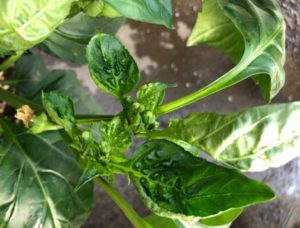
Figure 3. Bell pepper 2 weeks after treatment. The leaves are cupped with a bubble-like texture on the top surface.

Figure 4. Tomato 2 weeks after treatment. Leaflets are curled, reduced in size, and deformed.
For eggplant and bell pepper, injury was expressed as the undersides of the leaves curling upward toward the top surface (Figures 2 and 3). Additionally, leaf crinkling is seen in bell pepper foliage (Figure 3). Finally, tomato plants express dicamba injury with leaf twisting, cupping, stunting, and crinkling. At higher rates, these leaflets will be extremely stunted and deformed (Figure 4). Lower rates will show slight cupping, leaf crinkling and a change in leaf surface texture. Among the most tolerant crops from this study were basil, pumpkin, lettuce, and kale. These plants incurred the lowest amount of damage. The moderately sensitive crops included watermelon, cucumber, and summer squash. Watermelon foliage exhibits injury differently than many of the other crops tested in the study. Rather than leaf cupping, watermelon leaf texture appears shriveled and more deeply lobed with small bubbles on the top leaf surface (Figure 5).
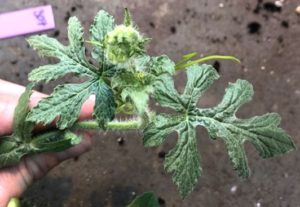
Figure 5. Watermelon 2 weeks after treatment. Leaves are deeply lobed with a puckering, bubble-like texture.
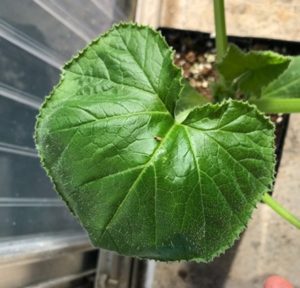
Figure 6. Summer squash 2 weeks after treatment. Leaf edges are curved downward toward the ground.
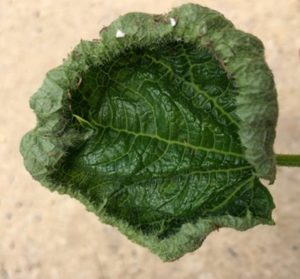
Figure 7. Cucumber 2 weeks after treatment. Leaf is cupped and the bottom edges of the leaf are curved upward towards the top leaf surface.
Summer squash and cucumber, however, show leaf cupping when injured. In summer squash, the top edges of the leaf curve downward towards the ground (Figure 6). The foliage of cucumber tends to curve the bottom edges upward toward the top surface of the leaf, although both directions of cupping were observed. (Figure 7).
On-Going Research at Rutgers
This summer, Rutgers researchers will select a few of these crops to take yield in a field-based dicamba drift study that tests different drift rates and application timings. Although this study gives some preliminary information, more detailed studies are necessary to confirm these findings. However, in the meantime, this greenhouse work gives us a brief snapshot of which species to be most concerned with when working near dicamba treated fields and provides help with field identification of these injury symptoms.
If you suspect that dicamba drift may have injured your crops, please contact you local county extension agent or Rutgers weed science specialist (Dr. Thierry Besançon) as soon as possible, and take detailed pictures of the observed damages.
